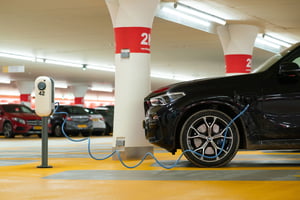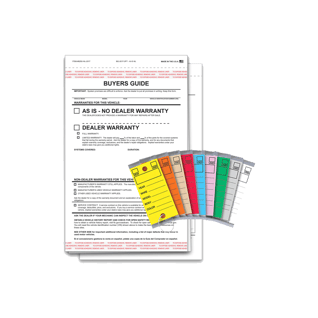
MSADA and AIADA Issue Guidance on New Biden Inflation Reduction Act
The following is an excerpt from an article by our friends at MSADA:
"The Internal Revenue Service issued the following consumer guidance document, Plug-In Electric Drive Vehicle Credit (IRC 30D), describing the implementation of the revised tax credits program, which will have serious implications for dealership sales and lease operations for qualifying “clean” vehicles, especially in regards to sales executed pre-August 16 and those executed after the signing of the bill. The link for the IRS Guidance document is available here.
Here is the complete text of the IRS guidance:
Plug-In Electric Vehicle Credit IRC 30 and IRC 30D | Internal Revenue Service (irs.gov) Updated information for consumers as of August 16, 2022
New Final Assembly Requirement
If you are interested in claiming the tax credit available under section 30D (EV credit) for purchasing a new electric vehicle after August 16, 2022 (which is the date that the Inflation Reduction Act of 2022 was enacted), a tax credit is generally available only for qualifying electric vehicles for which final assembly occurred in North America (final assembly requirement).
The Department of Energy has provided a list of Model Year 2022 and early Model Year 2023 electric vehicles that may meet the final assembly requirement. Because some models are built in multiple locations, there may be vehicles on the Department of Energy list that do not meet the final assembly requirement in all circumstances.
To identify the manufacture location for a specific vehicle, please search the vehicle identification number (VIN) of the vehicle on the VIN Decoder website for the National Highway Traffic Safety Administration (NHTSA). The website, including instructions, can be found at VIN Decoder.
Transition Rule for Vehicles Purchased before August 16, 2022
If you entered into a written binding contract to purchase a new qualifying electric vehicle before August 16, 2022, but do not take possession of the vehicle until on or after August 16, 2022 (for example, because the vehicle has not been delivered), you may claim the EV credit based on the rules that were in effect before August 16, 2022. The final assembly requirement does not apply before August 16, 2022.
Vehicles Purchased and Delivered between August 16, 2022, and December 31, 2022
If you purchase and take possession of a qualifying electric vehicle after August 16, 2022, and before January 1, 2023, aside from the final assembly requirement, the rules in effect before the enactment of the Inflation Reduction Act for the EV credit apply (including those involving the manufacturing caps on vehicles sold). If you entered into a written binding contract to purchase a new qualifying vehicle before August 16, 2022, see the rule above.
What Is a Written Binding Contract?
In general, a written contract is binding if it is enforceable under State law and does not limit damages to a specified amount (for example, by use of a liquidated damages provision or the forfeiture of a deposit). While the enforceability of a contract under State law is a facts-and-circumstances determination to be made under relevant State law, if a customer has made a significant non-refundable deposit or down payment, it is an indication of a binding contract. For tax purposes in general, a contract provision that limits damages to an amount equal to at least 5 percent of the total contract price is not treated as limiting damages to a specified amount. For example, if a customer has made a non-refundable deposit or down payment of 5 percent of the total contract price, it is an indication of a binding contract. A contract is binding even if subject to a condition, as long as the condition is not within the control of either party. A contract will continue to be binding if the parties make insubstantial changes in its terms and conditions.
Future Guidance
To reduce carbon emissions and invest in the energy security of the United States, the Inflation Reduction Act of 2022 significantly changes the eligibility rules for tax credits available for clean vehicles beginning in 2023. The Internal Revenue Service and the Department of the Treasury will post information and request comments from the public on various existing and new tax credit incentives in the coming weeks and months. Please look for updates on IRS.gov and other announcements from the Administration.
Pre-Inflation Reduction Act of 2022 Information
The information below pre-dates the enactment of the Inflation Reduction Act of 2022 but, subject to the final assembly rule described above, remains relevant for qualifying vehicles purchased and delivered prior to January 1, 2023.
Internal Revenue Code Section 30D provides a credit for Qualified Plug-in Electric Drive Motor Vehicles including passenger vehicles and light trucks.
For vehicles acquired after December 31, 2009, the credit is equal to $2,500 plus, for a vehicle which draws propulsion energy from a battery with at least 5 kilowatt hours of capacity, $417, plus an additional $417 for each kilowatt hour of battery capacity in excess of 5 kilowatt hours. The total amount of the credit allowed for a vehicle is limited to $7,500.
The credit begins to phase out for a manufacturer’s vehicles when at least 200,000 qualifying vehicles have been sold for use in the United States (determined on a cumulative basis for sales after December 31, 2009). For additional information see Notice 2009-89.
Section 30D originally was enacted in the Energy Improvement and Extension Act of 2008. The American Recovery and Reinvestment Act of 2009 amended section 30D effective for vehicles acquired after December 31, 2009. Section 30D was also modified by the American Taxpayer Relief Act (ATRA) 2013 for certain 2 or 3 wheeled vehicles acquired after December 31, 2011 and before January 1, 2014.
The vehicles must be acquired for use or lease and not for resale. Additionally, the original use of the vehicle must commence with the taxpayer and the vehicle must be used predominantly in the United States. For purposes of the 30D credit, a vehicle is not considered acquired prior to the time when title to the vehicle passes to the taxpayer under state law.
Notice 2009-89 applies to vehicles acquired subsequent to December 31, 2009, and provides procedures that a vehicle manufacturer may use if it chooses to certify that a vehicle meets certain requirements that must be satisfied to claim the Qualified Plug-in Electric Drive Motor Vehicle Credit and the amount of the credit allowable with respect to that vehicle.
Credit Amounts for Qualified Vehicles Acquired After December 31, 2009
Credit Amounts for Qualified Vehicles Acquired After December 31, 2009
Qualified Plug-In Electric Drive Motor Vehicle Credit (IRC 30D) Phase Out
The qualified plug-in electric drive motor vehicle credit phases out for a manufacturer’s vehicles over the one-year period beginning with the second calendar quarter after the calendar quarter in which at least 200,000 qualifying vehicles manufactured by that manufacturer have been sold for use in the United States (determined on a cumulative basis for sales after December 31, 2009) (“phase-out period”). Qualifying vehicles manufactured by that manufacturer are eligible for 50 percent of the credit if acquired in the first two-quarters of the phase-out period and 25 percent of the credit if acquired in the third or fourth quarter of the phase-out period. Vehicles manufactured by that manufacturer are not eligible for a credit if acquired after the phase-out period.
Quarterly Sales by Manufacturer "
Quarterly Sales by Manufacturer "
PARTNER SPOTLIGHT
Dealer Management System, Computer Technology, Media/Advertising, Automotive Auction, F & I/Aftermarket Products, Automotive Technology Training & Compliance
 A NHADA Gold PARTNER
A NHADA Gold PARTNERComputer Technology, Automotive Shop Equipment, Environmental Services
 A NHADA Platinum PARTNER
A NHADA Platinum PARTNERF & I/Aftermarket Products, Automotive Technology Training & Compliance, Environmental Services
.png?width=150&name=corp_logo_horz_on_light_with_trademark_symbol_1200w%20(002).png) A NHADA Diamond PARTNER
A NHADA Diamond PARTNERWe also received a response from the AIADA:
"U.S. Says About 20 Models Will Get EV Credits Through End of 2022 After Biden Signs Tax-Climate Bill
President Joe Biden signed the sweeping tax, climate and health-care measure into law on Tuesday. Automotive News reports the Biden administration said about 20 models will still qualify for electric vehicle tax credits of up to $7,500 through the end of 2022 under the legislation. Click here to see which EVs are eligible for tax credits. The law signed Tuesday immediately ends credits for about 70 percent of the 72 models that were previously eligible, said the Alliance for Automotive Innovation, an industry trade group. To qualify, EVs must now be assembled in North America. Click here to see guidance from the IRS.
AIADA President and CEO Cody Lusk released the following statement. “With yesterday’s enactment of the IRA, the number of electric vehicles sold in the U.S. eligible for a tax credit has plummeted. No vehicles assembled outside of North America are currently eligible for a credit, and until the end of the year the cap of 200,000 units still applies to manufacturers. AIADA will continue to work in Washington, D.C., to clarify elements of this legislation and to communicate vital information to both dealers and consumers.” Click here for the full story.
AIADA President and CEO Cody Lusk released the following statement. “With yesterday’s enactment of the IRA, the number of electric vehicles sold in the U.S. eligible for a tax credit has plummeted. No vehicles assembled outside of North America are currently eligible for a credit, and until the end of the year the cap of 200,000 units still applies to manufacturers. AIADA will continue to work in Washington, D.C., to clarify elements of this legislation and to communicate vital information to both dealers and consumers.” Click here for the full story.


















.png?width=150&name=Ally_Final%20Logos%20and%20Pairings_11.14.2018-01%20(2).png)


-2.png?width=150&name=Wipfli%20Logo%20Blue%20RGB%20(1)-2.png)


.jpg?width=150&name=NHADA_Partner_FTR_Img_NHADA_Insurance%20(1).jpg)


.jpg?width=150&name=NHADA_Partner_FTR_Img_JMA(1).jpg)


